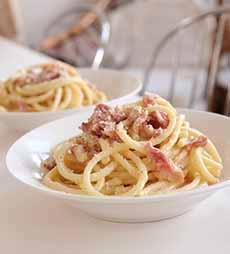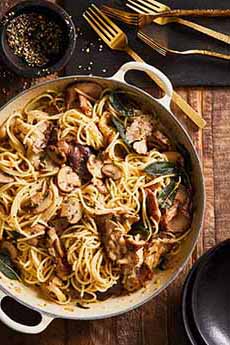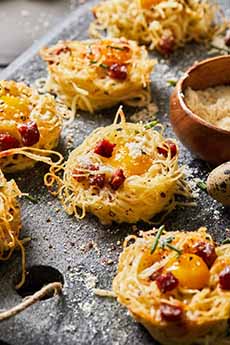Spaghetti Carbonara Recipe & More Recipes For National Carbonara Day
|
|
For National Carbonara Day (a.k.a. International Carbonara Day), April 6th, we begin our presentation of this Spaghetti Carbonara recipe with a disclaimer: Carbonara purists will agree only that the Spaghetti Carbonara recipe that follows is authentic carbonara. The additional carbonara recipes below are not. (In Italy, the dish is called Spaghetti alla Carbonara.) > The classic recipe is below. Their rule is that, in addition to the pasta, only five other ingredients are permitted in a carbonara: bacon, cheese, egg, salt, and pepper. They slice the debate further: Garlic and onions? Sheesh! Olive oil? Nope; the bacon fat will suffice. Cream? Never—that’s Fettuccine Alfredo. How about those poached eggs atop the spaghetti (photo #3)? Mamma mia! The egg whites (when used) serve to combine with the starch in the pasta water to add viscosity to the sauce, while the yolks add richness and flavor. In sum: a truly authentic carbonara mixes spaghetti with guanciale and pecorino, using the egg yolk, guanciale fat, and pasta water to create a sauce, seasoned with black pepper. And don’t even think of substituting dried red chile flakes for the black pepper—that’s Arrabbiata Sauce. > The history of Spaghetti Carbonara. So what about those so-called carbonara recipes such as the ones below, as well as the many other “carbonaras” you may come across, laden with shrimp, topped with a poached egg, tossed with peas and asparagus (“spring carbonara”) or anything other than the following recipe? Call them non-authentic carbonara or carbonara wanna-be’s. The laborers for whom the dish was named didn’t have shrimp or poached eggs. They were making a quick lunch. The name “carbonara” comes from carbonaro, Italian for a coal burner. It is believed that the dish was created as a hearty, easy-to-make meal by men working outdoors for long periods, who used a portable coal burner to cook the dish. There’s a lot of adaptation of iconic recipes to suit food trends. Here’s our discussion on “Is it still a carbonara if you change the ingredients?”, “Margarita Vs. Not A Margarita,” and “What’s A Kir? What’s A Margarita?” But at the end of the day, we serve to educate. Now that you know what authentic Spaghetti Carbonara is, we’ve done our job. This recipe does add a bit of olive oil, as needed, to help cook the bacon. If you can’t find guanciale or pancetta, substitute streaky (American) bacon—which will render plenty of its own fat, no olive oil needed. 1. BRING an 8-quart pot of salted water to a boil. Add the pasta and the salt and cook until al dente (this is typically 1 minute less than the package directions, but taste a strand to check). Stir often to prevent the spaghetti from sticking. Reserve 1 cup of the pasta water and drain the pasta. While the spaghetti cooks… 2. PLACE the guanciale or pancetta in a 12-inch heavy-duty skillet. Cook over medium heat, stirring occasionally until the bacon is golden-brown but not yet crisp (3 to 5 minutes for guanciale, 5 to 7 minutes for pancetta. If not enough fat is rendered (it will be used to make the sauce), feel free to add olive oil. Once cooked, remove the skillet from the heat. Immediately add the drained pasta and toss. 3. WHISK the eggs, Parmigiano-Reggiano, and 1/4 teaspoon black pepper in a medium bowl until well combined. Slowly whisk in 1/4 cup of the reserved pasta water. Quickly pour this mixture into the skillet, tossing continuously with tongs until the pasta is well coated, 15 to 30 seconds. Add more of the reserved pasta cooking water if needed to achieve a creamy consistency. 4. SERVE immediately. Provide a peppermill so individuals can add additional black pepper to taste. We like to pass a bowl of grated Parmigiano in case anyone would like more. > The difference between Parmigiano-Reggiano and parmesan cheese. > The different types of pasta. *While Parmigiano-Reggiano is the nation’s darling, pecorino, the hard sheep’s milk cheese hails from the area between Lazio and Abruzzo where carbonara was born. |
|
|
|
||





